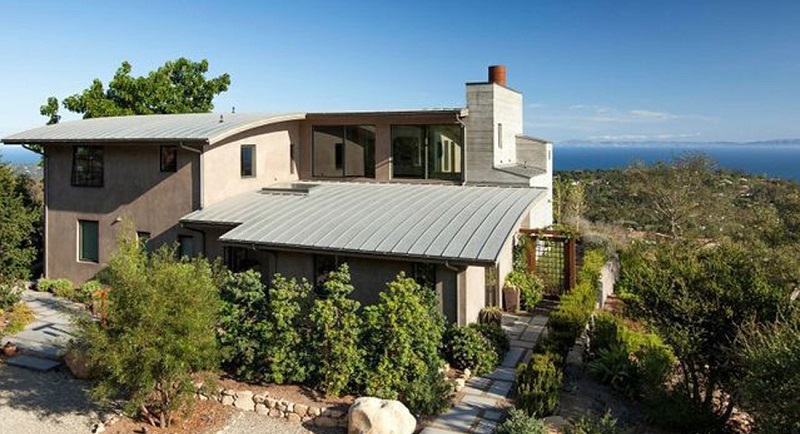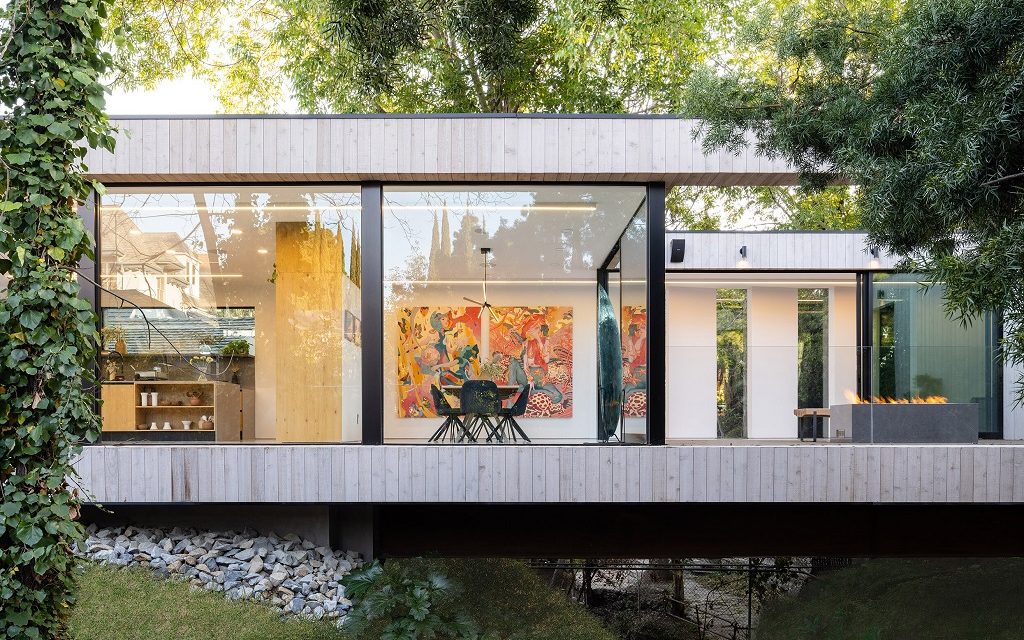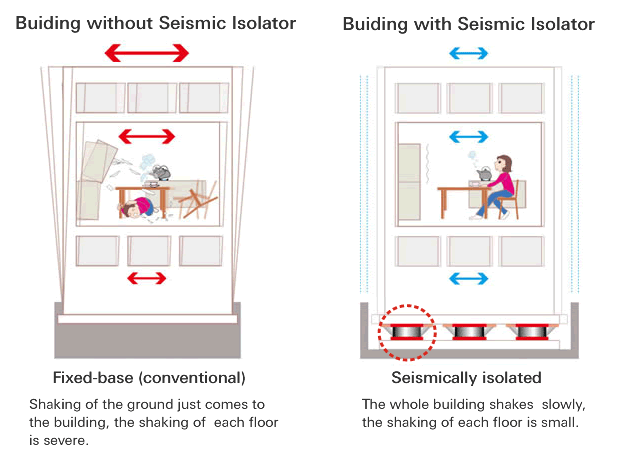Updated: May 11, 2023
The main photo is courtesy of Dan Brunn Architecture (DBA), their Bridge House Project in Los Angeles, CA, in partnership with BONE Structure.
Innovative building technologies that are making an impact on both the building trade and homeowners, as these materials and methods prove themselves during actual disasters.
Natural disasters are a common occurrence any time of year, any place in the world. In fact, 77% of homes built in the US are prone to some type of natural disaster. In 2017, there was an estimated $300 billion in damages caused by natural disasters in the US, from wildfires in the West to hurricanes in the East.
Whether it be wildfires, earthquakes, floods, hurricanes or tornadoes that are perennial threats to your most important asset, there are newer methods and technologies to protect your home from the ravages of nature and lessen the severity of damages.
Designing and constructing a home impervious to natural threats is not new. Increasingly, however, innovative technologies are making an impact on both the building trade and homeowners, as these materials and architectural designs prove themselves during actual disasters.
Many of these technologies have been widely used around the world for many years with great success. Which begs the following questions:
Why has the US been resistant to changes in building technologies and why are we lagging behind the rest of the world?
Table of Contents
- Fire Resistant Building Materials
- Earthquake Resistant Building Methods & Materials
- Tornado, Hurricane and Wind Resistant Building Materials
- Additional Disaster Resistant Resources
Also see:
Fire Resistant Building Materials
Perhaps the most challenging element from which to protect any structure is fire. The National Interagency Fire Center (NIFC) releases a report each month, the Wildland Fire Potential Outlook, which forecasts wildfire potential throughout the United States.
According to the August 2021 report, droughts, which have expanded across the West to over 95% of the area, are exposing over half of the region to extreme, exceptional drought and thus, a high risk of wildfire.
Combine this with the fact that homebuilders are still using conventional materials and methodologies, such as stick frames and full on-site builds, leads to a perilous situation. This worrisome circumstance exists despite the fact that more cost-effective and disaster-resistant methods and materials are currently available.
Regardless of this dire outlook, there is much that homeowners can do to keep their homes safe from fire, from both a design and materials perspective. One of the most interesting developments in construction technologies is interlocking 3D panels, which is composed of EPS (Expanded Polystyrene Foam), concrete and steel.
EVG 3D Construction System & RSG 3-D
With an award-winning, Class A fire-rated building product, Re-Structure Group 3-D (RSG 3-D) has licensed welding technology from EVG 3D to bring their technology to the US market. This resultant product, known as a 3D panel building system, is being hailed as a globally proven solution and the strongest building system available.

Image courtesy of RSG 3-D
The interlocking 3D cementitious sandwich panel, comprises fire retardant EPS (Expanded Polystyrene) foam sandwiched between 3-dimensional wire meshed faces. The faces are connected via 11 gauge reinforcement wires that go through the foam, while the entire “sandwich” is enveloped in concrete.
Ken Calligar, CEO of RSG 3-D, explains:
“A wood structure would combust almost immediately and studies show that once a wood structure has four or five percent of the building on fire, it becomes a total loss because there is no stopping the fire. There is no place for a fire in a 3D panel building to start.“
Winner of the 2019 National Association of Home Builders Global Innovation Award, the RSG 3-D building panel can change the way we look at insurance rates, wild fires and construction. The company proudly proclaims that its building systems are resilient and safe from all natural disasters.
Also see:
Boxabl
For a full review of Boxabl see our expanded company profile. The most important aspect of their building system materials is Boxabl’s use of a similar EPS, steel and concrete framing as the RSG 3-D product. As further reinforcement, Boxabl coats each panel with a polyurethane adhesive for strength, while the interior of the wall is composed of ceramic MgO or Magnesium Oxide board, which is non-combustible.

Boxabl’s outdoor exhibit at IBS 2023
Earthquake Resistant Building Methods & Materials
Seismic activity is becoming more prevalent each year, with an average 20,000 earthquakes each year. However, advances in construction technology have mitigated concerns, even when an earthquake measures high on the Richter Scale, as the damage is not caused by the earthquake itself, but by collapsing structures with people in and around them.
Seismic Base Isolators
The best technologies redistribute the forces of an earthquake by dissipating the energy that travels through a structure during a seismic event. This is the premise behind a low cost, seismic sliding isolation system or Sliding Base Isolator, developed by engineers at Stanford University. A test performed in 2014, on a seismic “shake table”, demonstrated the product’s strength through a simulated earthquake that was actually 3 times the strength of the 1989 Loma Prieta earthquake.
Interestingly, the house used in the quake simulation was not affixed to a foundation, but rather rested on a dozen of the steel and plastic sliders, which are 4.5.inches in diameter. The sliders sit on bowl-shaped dishes made of galvanized steel or seismic isolators. The technology has proven itself in large commercial structures, such as San Francisco City Hall and San Francisco International Airport.
The Seismic Isolation Approach is actually the opposite of the older, conventional approach of increasing a building’s rigidity by adding shear walls or braced frames while bolting the structure to the foundation. Advanced technology takes a flexible approach of isolating the structure from the ground, and thereby reducing seismic shock energy into the structure.
This inexpensive design modification, costing between $10,000 and $15,000 of a 1,500-2,000 square foot house’s total cost, can be combined with the RSG 3-D panels, which have a 9.0+ Richter rating. The combination of the two would result in a home that would not warrant earthquake insurance.
Bridgestone Corporation
Bridgestone’s Seismic Base Isolation System is a proven technology for building an earthquake resistant structure. Known for its wide-range of superior tires and other diversified rubber-based products, Bridgestone has leveraged cutting edge technology to become the pioneer in seismic isolation bearings which they manufacture in Japan.
Their Seismic Isolating Rubber Bearing System consists of alternating laminations of thin rubber layers and steel plates (shims), bonded together to provide vertical rigidity and horizontal flexibility.
Vertical rigidity assures the isolator will support the weight of the structure, while horizontal flexibility converts destructive horizontal shaking into gentle movement.
BONE Structure
Dan Brunn Architecture (DBA), in collaboration with BONE Structure, unveiled Bridge House, a Los Angeles, California home constructed with precision, framed entirely of steel that straddles a natural stream. What makes this house architecturally significant is the same technology that provides earthquake resistance, a seismically resistant frame made of 89% recycled steel.
Video courtesy of Open House TV.
Bone Structure, based in Quebec, Canada, is a designer and builder of luxury custom homes using an innovative and lightweight steel frame system that is laser cut in a factory and delivered on-site for assembly. Many of the designs constructed with BONE Structure frames would never have been possible with older, traditional lumber builds. The steel frames are made to last and require no interior load-bearing walls, making this one of the most transformable, adaptable and reconfigurable framing structures currently available.
The company is currently offering complimentary analysis and discounted service rates to victims of California’s recent wildfires.
Tornado, Hurricane and Wind Resistant Building Materials
With decades of experience, residents of Florida, Georgia and other hurricane and tornado prone states know the best wind-resistant materials. Taking a page from the children’s tale The Three Little Pigs, it was the brick house that outlasted the destruction of the Big Bad Wolf. Brick or masonry block combined with steel is considered the best protection against wind-based natural disasters beyond the building code’s requisite 195 mile per hour wind speed requirement.
RSG 3-D
Again RSG 3-D’s interlocking panels are the hands-down winner for proven technologies that can withstand a natural disaster. For example, in 1991, Habitat for Humanity rebuilt ravaged structures in Dade County, Florida and parts of Georgia using these panels.
These same homes survived Hurricane Andrew in August of 1992 and were deemed safe with no structural damage. This was a result of choosing reconstruction with 3-D cementitious sandwich panel over lower quality, traditional lumber builds. RSG’s panels have been tested to hurricane wind forces of 300+ miles per hour in real life storms.
Boxabl
Fortified with a galvanized steel and concrete core, Boxabl’s panels are the ideal, wind resistant construction material for its mass produced, architecturally neutral, universal building blocks. These modular boxes, shipped in a folded form, can suit a wide-range of designs and applications anywhere in the world. Rated for hurricane speed winds and resistant to flying debris, they can handle the worst North American wind conditions.
Additional Disaster Resistant Resources
- How Earthquake-Proof Buildings Are Designed
- 10 Technologies That Help Buildings Resist Earthquakes
- A BONE Structure Home Rises From the Ashes in Santa Rosa, CA
- Bridge House
Related Articles
- The Traits & Risks of Dangerous Trees: Is Your Property Safe?
- Boxabl: Transformable Design + Automation = Affordable Housing
- Why Homeowners Should Invest in a Prefab ADU
- Choosing Between a Prefab ADU and a Traditional Stick-Built ADU
- What to Consider Before Purchasing a Shipping Container Home
- Shipping Container Homes: Questions & Answers
- Never Thought You’d Own Land? Think Again!
- Home Inspection Technologies to Alleviate Your Purchase Anxiety
- Drone Technology for Homeowners: 7 Use Cases
| Purgula is reader-supported. When you click on links to other sites from our website, we may earn affiliate commissions, at no cost to you. If you find our content to be helpful, this is an easy way for you to support our mission. Thanks! Learn more. |








